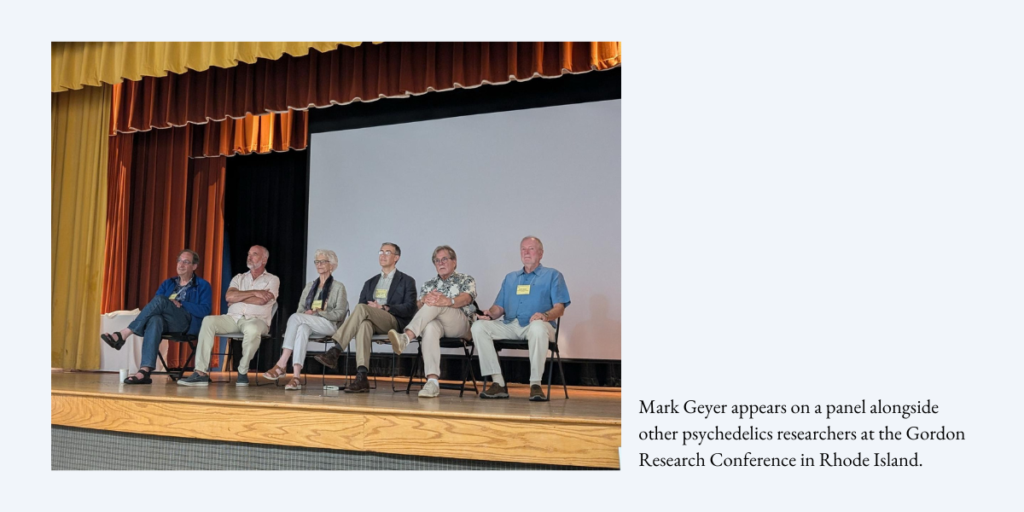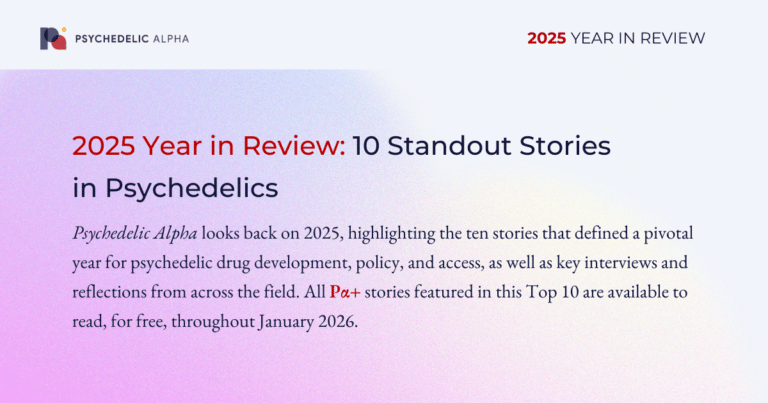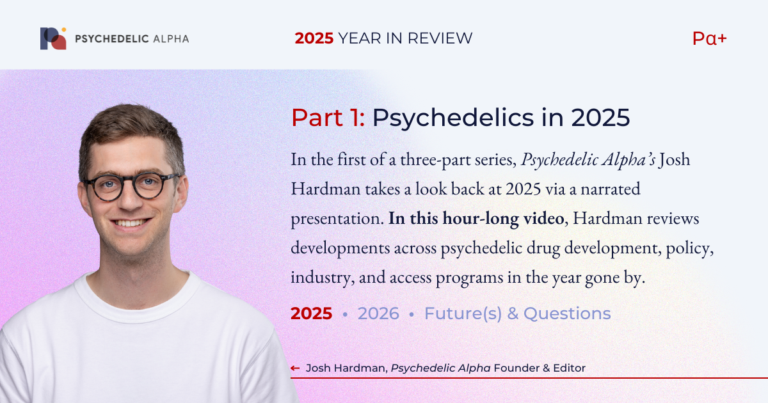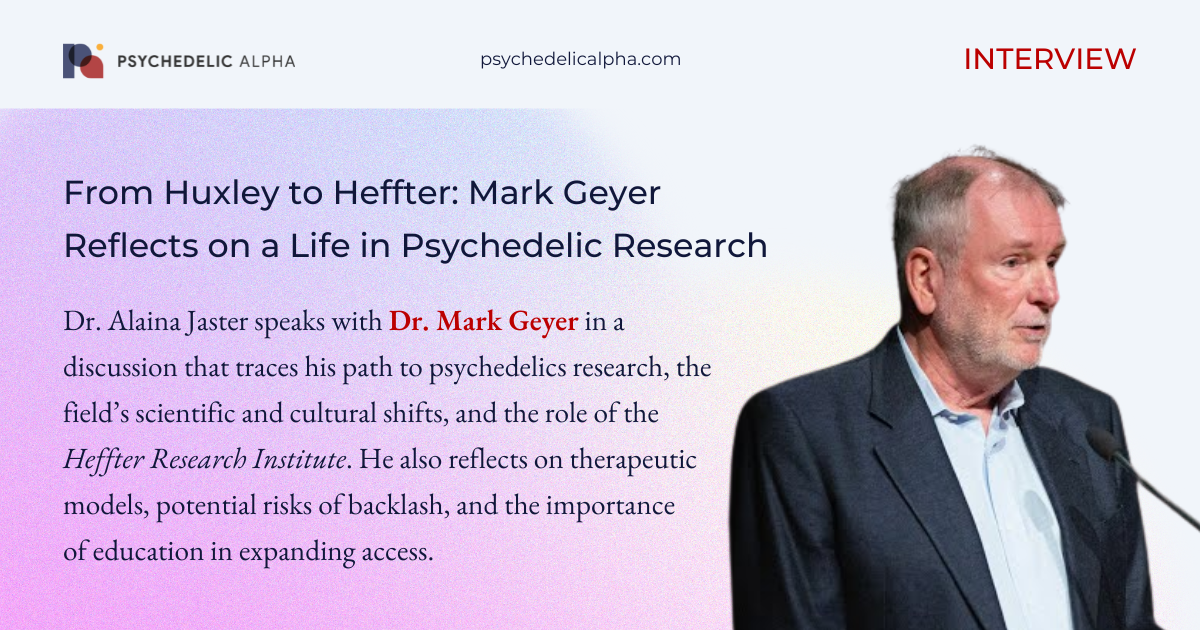One of the things that made the recent Neurobiology of Psychedelics Gordon Research Conference (GRC) special was that it provided a venue for junior scientists to interact with pioneers of the field. With such a small attendee list and a one-track scientific agenda, conference-goers were able to network and learn directly from the best of the best.
One of those pioneers is Dr. Mark Geyer, Professor Emeritus at the University of California, San Diego and long-time contributor to the psychedelic science field. In 2023, Geyer published a historical review of some of the major events in the history of psychedelic science, and he presented on this topic at the GRC.
His talk, Neuropsychedelia: From Psychotogens to Psychotomimetics to Psychotherapeutics, covered almost a century of discovery and science related to psychedelic compounds.
After the talk, Dr. Alaina Jaster sat down with Geyer to get his perspectives on the changing landscape of psychedelic science.
Alaina Jaster, for Psychedelic Alpha: How did you become interested in psychedelics?
Mark Geyer: Well, I was pre-med. It was my sophomore year at the University of Oregon, and Aldous Huxley came and gave a talk in April of 1963. He passed away on November 22nd that year.
He talked about the varieties of religious traditions and varieties of psychedelic experiences, and both of those aspects intrigued me. I began to experiment some with psychedelics, and while they were legal, they were not widely available. So I switched my goals to pre-med. I decided I wanted to study the brain. So, that’s what I did.
Jaster: And here we are.
Geyer: And here we are!
Jaster: Do you remember your first experiment with psychedelics?
Geyer: I remember my first attempt—grinding up some morning glory seeds. They tasted bad. Maybe there were some brain changes, but not much.
I don’t know if I remember my first LSD trip, which I think was next. I don’t think I remember my very first psychedelic experience, but I remember my first DMT experience vividly because it’s a very profound and intense experience. It’s only twenty minutes, but it’s very intense.
Jaster: So you mentioned your interests in the scientific and spiritual aspects, and how psychedelics were legal at that time. How easy was it to get into research at that time?
Geyer: I didn’t exactly start doing research in psychedelics. I wasn’t doing research as a sophomore in college. I started reading more. The previous two years I had been in the process of an adolescent-sophomoric exploration of religious institutions, trying to figure out if there were any worth attending.
During that period was the Huxley lecture. I read two of Huxley’s books, one was The Doors of Perception, but the one which had more impact on me was a book called The Perennial Philosophy. Very few have laboured through it, but it’s a very scholarly work exploring the notion of the perennial philosophy. The construct was that all human religious traditions have a core philosophy, and so Huxley systematically explored that cross-culturally across time, which put to rest my exploration.
One summer before college, me and a friend of mine went to a different church, mosque or synagogue every week to explore these things. I’ve never been a theist or had a belief in some entity. So, Huxley’s book resolved that and put that notion to rest, but it also intrigued me into the possibility of mystical kinds of experiences.
So those two constructs, the psychedelia and altered states of consciousness—both drug-induced versus altered life view and consciousness perspective associated with religious practices—merged. It did not become a religious conceptualisation in my mind, but more a neuroscience outlook. Though I don’t think the term neuroscience existed yet.
Jaster: I think that was later?
Geyer: It was around the time the neuroscience program started, the formal use of the term was beginning.
So, senior year of college, I was in the Honors College of the University of Oregon, a small cluster within the larger university. We had to take broad multidisciplinary courses for generalisation, and we had to do an undergraduate thesis. So I started doing research then, at the beginning of my senior year. The research I was doing was in a psychology laboratory, doing what we then began to call “physiological psychology.”
Jaster: The beginning of neuroscience?
Geyer: Yes, and the term psychobiology had just evolved at UC Irvine. There was a program there in psychobiology. There was a guy at our University that had some connection to them. So I did research with rats, testing drugs on rats and behaviour.
Jaster: Nice, so that’s how it all began?
Geyer: Yes. Curiously, though, when I was in high school, we did science fair projects. I did one testing hamsters and their behaviour, where one group got regular food and one group got vitamin food supplements. I built a maze and designed a little test. Somehow, that predicted later on that I would be doing those types of experiments, and I even started a behavioural equipment company, San Diego Instruments.
Somehow, I think I was destined to become an experimental psychologist.
Jaster: That’s cool, how those experiences kind of predicted where you ended up, even if you didn’t realise it at the time.
Geyer: Apparently I was interested in that sort of thing before I knew I was interested in that sort of thing, or that it even was a sort of thing.

Jaster: I’ve heard from a lot of people who are in the psychedelics field that there is the camp of people who get into it because they’re curious about schizophrenia and the psychosis-mimicking effects in the brain, and there’s the other camp who get into it because of religious and spiritual interests and understanding the visualisations. Would you say this is what you’ve seen, or is there another reason?
Geyer: Well, I got into it for both those sides, but I also got into it for a third, which is what I would call “recreational pharmacology”, because I enjoyed the experiences. I certainly got interested in psychosis because one of my revelations when I had things like LSD was: “The brain can be that way.” The brain can be altered in ways I had never experienced naturally.
The thought occurred to me: if you were to have those experiences without a drug to explain them, and they didn’t stop, then you would be having experiences like those who are diagnosed with schizophrenia. The notion that that experience could be what the illness is like. If it were like this for the rest of your life, oh boy, that would not be good. But it made me interested in understanding whether there was a relationship there.
Jaster: Looking back on that kind of research, calling psychedelics psychotomimetics, do you think that term is still relevant? Now they’re called psychotherapeutics, so do you think there is still a place for psychotomimetic research?
Geyer: Absolutely. I think we have learned things about psychosis with the psychomimetic models with these kinds of drugs; not just what we call the classical or serotonergic psychedelics, it’s also the dissociative anaesthetics, which produce some overlapping but different interactions. They both provide psychotomimetic models but mimic different aspects, and they respond differently to treatment with antipsychotics.
I think if we had given more credence, or the American psychiatry field had given more credence, to the psychotomimetic model, we would have developed better antipsychotics earlier. I think we still could; there is still room to use that strategy to improve treatment, whether for schizophrenia or the group of related disorders. They all have different features and etiologies and therefore potential for different efficacies of treatment.
Jaster: More individualised medicine, essentially, for the severity of the disease?
Geyer: Yes, exactly.
Jaster: I think that’s the cool thing about psychedelics, that they lend themselves to that. That’s why I like the psychedelic medicine field so much, because it’s all about the individual experience and how we can tailor that with these compounds.
Geyer: Until rather recently, I didn’t have the conceptualisation that we do now, that these compounds can have these psychotherapeutic benefits. I always thought many people would be better off if they had these experiences; it would be better for society if everybody did, not that everyone should. I just knew I had benefited, and others had benefited in terms of their life trajectory and experience.
But when we started the Heffter Research Institute, there were some of the members that had the hope that they would be psychotherapeutic in some sense. I don’t think they were very clear on what would be treated. Franz [Vollenweider] and I, I think, were among the most skeptical among the ‘Heffties’ about that. I think a lot of that skepticism is because we were overly rigid in our thinking about what it means to have a pharmacological treatment. The field is still struggling with this rigidity.
The pharma model is that you get a pill a day, or two pills a day, a pill every other day, and you keep taking it in order to have your disorder treated. But this is a different paradigm that we’ve stumbled into.
Jaster: Yes, and how does it benefit the companies if you take something once and you’re better? It puts the whole system on its head.
Geyer: I’m amazed so many companies feel there is so much money to be made when they are only going to sell people a couple pills.
Jaster: Do you think that’s why a lot of people are trying to take the psychedelic experience out of it and have a pill? Or do you think that they would still only need to take that once or twice?
Geyer: Well, I don’t think it’s going to work at all.
Jaster: That’s what I was getting at. If you do think it’s going to work, how would it work? And if you don’t, why not?
Geyer: I mean, maybe there would be some clinical benefit of minidosing. I don’t believe microdosing will ever be an FDA-approvable thing, partly because there is no particular indication—people want different things. And also, talk about the placebo effect! People are doing this and everybody has their own unique expectations.
Maybe, boosting the amount of serotonin agonism in a mini-dose form, I suppose, may have some cognitive benefits or some sort of benefits. Identifying an indication that would be measurable enough to satisfy FDA and therefore get beyond non-FDA prescribable neurotropics. Maybe there’s something there.
In terms of the financial model that I would want to see if I were running a drug company, I don’t think non-psychedelic, non-big experience, 2A agonism is going to have the same effect as having the experience.
My analogy is PTSD, where a singular transient event happening at 2 o’clock on a Thursday changes your life. We accept that. That doesn’t shock us. So why should it shock us that a single positive event happening at 2 o’clock on a Thursday could do the same thing?
Jaster: That’s a great way to put it. I don’t think I’ve ever heard anyone put it straight like that.
Geyer: Having a life-changing experience and changing your perspective. I mean, the brain is plastic. We have neuroplasticity all the time. You see this pond? I’ve never seen this pond before, but my brain is changed by seeing this pond.
So I don’t think the non-hallucinogens are ever going to work. If it did, and it required repeated dosing, maybe there would be a fiscal model that would support a drug. I guess, my hunch is, that companies are thinking they’re gonna get not just the drug but the whole therapy model together and bill insurance companies for it.
Jaster: Let’s get back on track. One comment you made during your talk is that you wouldn’t recommend the field to people in the 1990s when you were building out the Heffter Research Institute. I’m curious about what some of the barriers were at the time.
Geyer: I was one of the few in the US who had chosen to take that area of research as part of my career. It wasn’t my whole career, but I had 33 years of funding from NIDA to study hallucinogens. In some sense it worked for me, but I couldn’t have built my whole career on that.
To recommend to an incoming graduate student that it would be a viable career path is like saying to your high school junior that loved playing the guitar that they should count on being a rockstar. A lot of kids want to play the guitar in a band, and not many of them make a living like that. So, my hesitation in urging young people to go into that field or take it as a career goal was purely pragmatic. Yeah, if you’re really passionate about it, ok, but be aware it’s gonna be really hard to get a job.
You couldn’t go to industry because the industry wasn’t doing it, didn’t look like it was going to be doing it. In the US, there’s a lot of stigma. If you used the term psychedelic, you couldn’t get funded. I had written my NIDA grant in terms of the dangers and harms of abuse potential, of which there are none, and yet that wasn’t what I was doing. I couldn’t go to NIMH to study psychotomimetics because American psychiatry dismissed that model. You could study serotonin receptor systems, but not as a potential for therapeutics or to understand psychosis—they didn’t buy it, mostly because of tolerance.
Jaster: Was this before or after Pimavanserin? Around the same time?
Geyer: That was before Pimavanserin. Pimavanserin was a minor success story. Others have tried other serotonergic antagonists as antipsychotics, M100,907 [Volinanserin], for example. The clinical trial was designed with the wrong clinical population; they should’ve done it with treatment-resistant patients that were typical antipsychotic non-responders.
So Pimavanserin came about only because of a company called Acadia, which was founded by Mark Brann, who was a strong believer in 2A antagonist antipsychotics. He moved from the Acadia National Park area to San Diego, started this company and brought me in as a consultant.
We worked together to try to realise his dream and a dream I shared from a different perspective. I believed there was a potential for 2A antagonism to be antipsychotic in a certain population. They tried and their clinical trials also didn’t succeed in schizophrenia patients, and couldn’t beat the comparator, which was risperidone and already had 2A antagonism.
So then, it was suggested to get a niche indication to get it approved for something and let doctors figure out what it’s good for, which is the same tactic we have with psilocybin. Get it approved for something so we can get it to patients, get it in the doctor’s hands without Schedule I, and we’ll find out what it’s good for. There’s no other way to know.
So anyway, we went to Parkinson’s, where you can’t have dopamine blockers, and that worked. It was our animal model that helped select the compound. So, I felt somewhat vindicated by that, but I still didn’t think that psychedelics per se were going to be therapeutic in the clinical sense they are now.
Jaster: Do you think any of the barriers are still around, or do you think it’s got better?
Geyer: Oh yeah! The pragmatic issues are essentially gone right now. How long will that last? I don’t know. There are jobs to be had now; there are over 100 companies in North America doing this. We’re on the stock exchange doing psychedelic drug discovery, so that’s a change in perspective.
We’ll find out what the current view of the NIH administration is. I’m skeptical, I don’t think NIMH is still interested. They sent out a list of things that we’d have to satisfy for NIMH to fund research on psychedelics, which, to me, looked like a list of reasons to decline funding.
Jaster: What do you think of the animal testing changes NIH is pushing for?
Geyer: I think it’s a disaster for preclinical research, not just for psychiatry, but throughout the NIH. I think it’s an expression of a lack of understanding in the current administration of the value of basic research. Obviously, animal research cannot be defined as applied research, but they have a very short-term agenda. Basic research benefits things 20 to 30 years from now; they’re very short-sighted. If this stays in effect, it’s going to be a major disruption in our research enterprise.
Editor’s note: A more detailed piece on NIH’s push to move away from animal studies, including reaction from psychedelics researchers, will be published shortly.
Jaster: Yeah, we’ll have to see what happens. Okay, switching gears, my last questions for you are: How would you describe the sense of community in the psychedelic science field, and what are your hopes for the field?
Geyer: The sense of community is good. I think there is a growing tension between people like me, who believe that you need to trip, and the people who I think must not have had the trip and therefore think you can have the therapeutic benefits without a profound experience.
Jaster: Do you think more people should be open about their personal experiences with psychedelics in the science community? I know many didn’t talk about it, due to fear of not being taken seriously.
Geyer: I’ve decided I’m going to be free about talking about the fact I’ve had these experiences. But I’m 80 years old, I’m not worried about it. I’m retired. But, I’m not sure I would suggest to graduate students that they not be a little circumspect.
Jaster: That’s fair.
Geyer: But generally, I think it’s an open community and, in fact, I think there is still one powerful force bringing us together as a community, which is that we are still very much a minority, or at least we feel like we are. So there’s a bonding, community, family experience that comes from that self-perception of being in the minority and having something of a cause. I don’t think it’s because a lot of us had MDMA, it’s just about the affiliated bonding of a goal.
But there are different people, different personalities, not necessarily a normal distribution of people in this field. As one of our Heffter founders, Dennis McKenna, would say when he witnessed people experiencing ego conflicts, “The medicines don’t always work”
Jaster: It’s true. Are there any final thoughts you have reflecting on your own work or the field as a whole?
Geyer: I’m delighted to see the clinical exploration, and it’s really exciting that the field is enabled to ask a bunch of questions that weren’t deemed worth asking before. The kind of science I’ve done for half a century was not then deemed worthwhile, but now is.
But the other elephant in the room, from my perspective, is the fear or the danger that an overabundance of enthusiasm may lead to risky behaviours, and we have another recurrence of what I experienced in the 60s, which is a shut-down. I’m concerned that something will happen and there could be a backlash, and we could get shut down again. It was sad then, and it would be sad again.
Jaster: Hopefully we don’t repeat that.
Geyer: If I had the power, I don’t know what I would do. I don’t really believe in prohibition, but I’m afraid of the consequences of decriminalisation.
Jaster: Like the access to substances without education?
Geyer: Yeah.
Jaster: That’s one of my biggest worries, too. In my heart, I believe that everyone should have access, but if we only have access without proper education and harm reduction, that’s bad. That’s what we need to have people benefit from it.
Geyer: Yeah! So that is a worry for me. It’s a “been there, done that,” that’s all too credible for me.
About the Heffter Research Institute
Geyer is one of the founding members of Heffter Research Institute (HRI). Founded in 1993 by David Nichols and colleagues, the goal of HRI was to provide a space where high-quality, rigorous studies of psychedelics could be supported and encouraged, especially in a time when few young investigators had the opportunity to build a successful career in the psychedelic science field.
“We tried to demonstrate that we could really do worthwhile research on psychedelics”, Geyer said, reflecting on the formation of HRI.
HRI did just that. According to Geyer’s review article, HRI-affiliated investigators have accounted for approximately 63% of the top-cited articles on serotonergic psychedelics. Interest in their psychotherapeutic effects grew well into the 2000s and 2010s, when clinical efficacy began to be demonstrated in end-of-life patients and treatment of major depressive disorder (MDD), post-traumatic stress disorder (PTSD) and tobacco addiction and alcohol dependence.
Collaborations and new companies grew from HRI and its affiliates. On the back of promising study results, HRI board member Bill Linton became passionate about bringing psilocybin to patients as an FDA-approved treatment for depression and founded the nonprofit drug developer Usona Institute. Here, they conducted Phase II clinical studies that led to psilocybin for MDD receiving a Breakthrough Therapy Designation from FDA.
Presently, there are around twenty psychedelic research centres in the U.S. and greater than a dozen more around the world. Many of these aim to understand mechanisms of psychedelic action, neuroplasticity and the therapeutic indications for a variety of psychedelics.
HRI has been instrumental in the founding of large institutional centres like the Johns Hopkins Center for Psychedelic Research and the NYU Center for Psychedelic Medicine. HRI continues to be a fixture in the psychedelics field, and most recently is funding the first human psychedelic study at Harvard in almost 60 years. This clinical trial will be using psilocybin for hospice patients at the Dana Farber Cancer Institute of Harvard Medical School.
For more on the Psychedelics GRC, read Dr. Alaina Jaster’s two-part Dispatch from the Psychedelics GRC: Dispatch: The Neurobiology of Psychedelics Gordon Research Conference.
You might also like…

2025 Year in Review: 10 Standout Stories in Psychedelics

2025 Year in Review: Looking Ahead to Psychedelics in 2026 (Video)

2025 Year in Review: Psychedelics in 2025 (Video)


